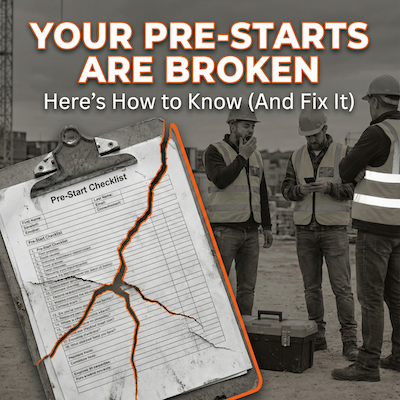When a former construction CEO and a Senior Safety Manager in a tier 1 construction company sit down to discuss the future of workplace safety, you might expect a clash of perspectives - theory versus practice, academia versus industry. Instead, what emerges is a fascinating exploration of how these seemingly opposing viewpoints might hold the key to transforming workplace safety culture.
In a wide-ranging conversation between Scratchie CEO James Kell and safety manager and researcher Ben Hutchinson, we see how the intersection of behavioural science, technology, and practical experience is reshaping our approach to workplace safety. Here are the key insights from their discussion:
1. The Audit Paradox: Beyond Checklists
The conversation begins with Hutchinson's research into safety audits, revealing a troubling paradox. As he explains: "Even for audits that apparently were focused on critical controls and the major risk systems, they virtually never actually spoke about the direct sources of harm." Instead of examining actual work practices and risk situations, audits often focus on proxies - checking plans and permits rather than observing real-world interactions.
This disconnect manifests in what Hutchinson calls "safety theater" - where organizations prepare extensively for audits but may not address fundamental safety issues. As Kell notes from his construction experience: "They showed me, they proudly showed me their, all their folders and they had all their paperwork underway... And I then I looked outside and the sharp edge of the deck, the form work had no handrail, no, nothing."
2. The Role of Rewards: Psychology Meets Practice
One of the most intriguing discussions centers on the role of incentives in safety management. While traditional approaches have often focused on punitive measures or lagging indicators like Lost Time Injury rates, Kell describes Scratchie's approach of immediate, positive reinforcement: "If you wanted to distill what we do down into one word, it's dopamine."
Hutchinson, while supportive of incentives' potential role, offers important nuance: "Incentives from the research tend to be short lived... we don't have a lot of good evidence that it leads to long term change or structural changes." This leads to a fascinating discussion about how incentives might work within broader systemic changes.

3. The Documentation Dilemma
A recurring theme throughout the conversation is the problem of excessive documentation. Referencing the work of Greg Smith, Hutchinson notes that courts and coroners are often "absolutely scathing around our paper systems." This raises fundamental questions about why organizations create such extensive documentation systems when they may not actually improve safety outcomes.
4. Design-Construction Disconnect
One of the most insightful observations comes from Hutchinson's comparison of design and construction phases: "The design is usually really sophisticated. They use a lot of really robust engineering tools and software. And then the project people that have to translate them to constructability, I feel like it's like almost the dark ages at times."
This gap between design and implementation represents a crucial opportunity for improvement in safety outcomes. As Kell notes from his carpentry background: "I remember something looking so easy, you know, and then when you actually have to make it work physically, it's so, there's always, it's so difficult."
5. Integrating Systems and Incentives
Perhaps the most valuable conclusion from the conversation is the recognition that systems-based approaches and individual incentives need not be mutually exclusive. As Hutchinson puts it: "I absolutely don't disagree with incentive, just like I'd have no issue, intrinsically with behavior... I think all these things can have a place."
Looking Forward
The conversation between Kell and Hutchinson demonstrates that improving workplace safety requires a multifaceted approach that combines academic research, practical experience, and technological innovation. As organizations continue to grapple with safety challenges, the integration of these perspectives - rather than their opposition - may offer the most promising path forward.
The discussion suggests that the future of workplace safety lies not in choosing between systems and incentives, documentation and action, or theory and practice - but in finding ways to harmonize these approaches in service of the ultimate goal: sending workers home safely every day.
If you'd like to discuss anything in this podcast/blog post, email Scratchie co-founder James Kell directly: here.
[Editor's Note: This blog post summarizes a wide-ranging conversation from Episode 15 of The Recognition Factor podcast. Future posts will dive deeper into each of these themes, examining their implications for safety professionals, managers, and workers alike.]










.svg)
